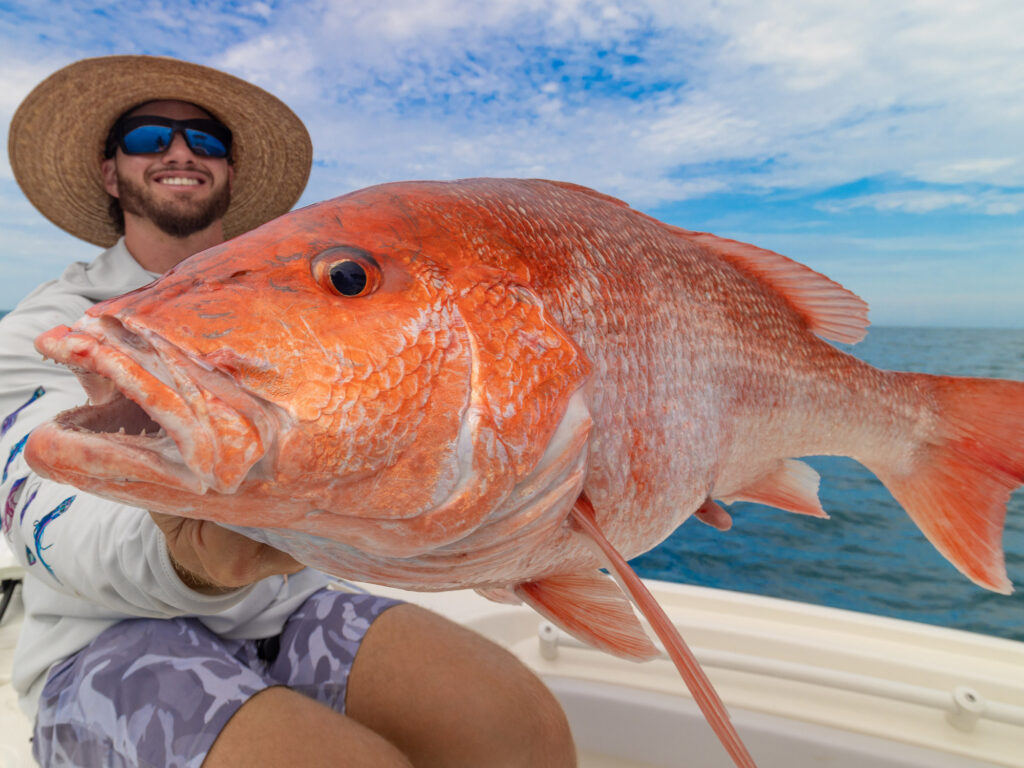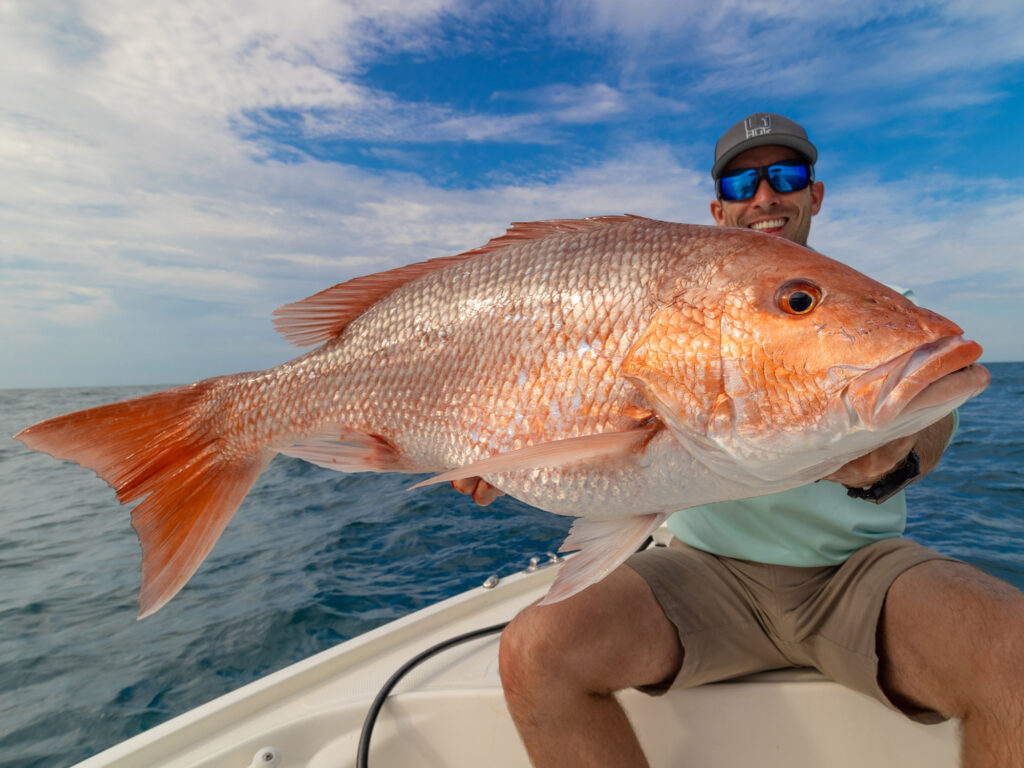Are Atlantic Bottom-Fishing Shutdowns Coming?
 Despite an exploding population and extremely limited seasons for red snapper, NOAA Fisheries says they are being overfished because of catch-and-release mortality.
Andrew Redwine
Despite an exploding population and extremely limited seasons for red snapper, NOAA Fisheries says they are being overfished because of catch-and-release mortality.
Andrew Redwine
Editor’s Note: Recently, in the ongoing controversy over red snapper, NOAA Fisheries informed the South Atlantic Fishery Management Council that it intends to bypass the normal route through which regulations are changed. Using a secretarial amendment, NOAA Fisheries has threatened to unilaterally amend the fishery management plan for the grouper-snapper fishery before 2025 bottom-fishing seasons. This is for Atlantic waters from Florida through North Carolina.
The Coastal Conservation Association (CCA) has come out strongly against this move by the federal government and is asking recreational anglers to make themselves heard by directly commenting before Nov. 8 via this link: https://www.regulations.gov/document/NOAA-NMFS-2024-0107-0001. Below, an op-ed from Ted Venker, director of conservation at the Coastal Conservation Association.
Anglers Called to Action on Red Snapper in the South AtlanticThe drumbeat that some anglers may be hearing in the South Atlantic isn’t their imagination. It’s the sound of NOAA Fisheries’ relentless efforts to slam the door on their fishing access. Using the red snapper fishery as a stalking horse, NOAA Fisheries is preparing to take the highly unusual step of a Secretarial Amendment to impose draconian fishing closures on anglers. Measures that not even the South Atlantic Council thinks are necessary or warranted given what is known about the fishery.
What is known about the fishery is that this is now perhaps the largest population of South Atlantic red snapper ever seen under management. It is a remarkable recovery since 2011 when the first-ever contemporary stock assessment conducted on the species revealed that it was severely overfished and undergoing overfishing. Since then, red snapper seasons have been virtually non-existent, and the fishery has come roaring back.
The challenge with red snapper is now three-fold. As the population has exploded, anglers have encountered them more often, and over an expanding range. Seasons have been closed (or open one or two days at most), but even when anglers don’t retain red snapper, the snapper caught when fishing for other species sometimes don’t survive release. Awareness and use of descending devices is growing exponentially and is effective.
It is not clear if there is a real impact to the stock, but NOAA says this release mortality is enough to massively overfish the stock. Since release data is unverified data from intercept surveys, NOAA can take exaggerated discards and multiply them by known-to-be-unreliable effort estimates to create a real problem. All that leads directly to the second challenge — NOAA’s recreational data system, which is a multi-decade, ongoing farce.
Uncertainty Over the South Atlantic Red Snapper Fishery Bottom-fishing closures would limit access to much more than red snapper. Species like grouper, black sea bass and vermilion snapper would also be inaccessible to anglers.
Andrew Redwine
Bottom-fishing closures would limit access to much more than red snapper. Species like grouper, black sea bass and vermilion snapper would also be inaccessible to anglers.
Andrew Redwine
NOAA’s recreational data system has already been overhauled twice in the past 15 years and is on its way to a third revision after the agency announced in 2023 that it is likely over-estimating recreational effort and harvest by up to 40 percent in some fisheries. The National Academies of Science has said on numerous occasions that even in its best form, the system is not appropriate for the way NOAA uses it.
Nevertheless, the agency continues to rely on it as a surrogate for real-time, to-the-pound measurement of what the recreational sector catches, what it brings to the dock and what it discards. As a survey designed to show trends over time, the system is neither timely nor accurate. Far from it. But because it has nothing else, NOAA calls the results “the best scientific information available” and it insists the regional fishery management councils use that information to base their management decisions … even when it is known to be wrong by up to 40 percent.
Finally, against this backdrop of data uncertainty, NOAA has been espousing the view that there are too many anglers on the water. The agency can’t tell you exactly how many anglers there are, but they assume it is too many which is laughable. More and more often, officials are working the term “effort rationalization” and “limited entry” for the recreational sector into management discussions. Arbitrarily appointing itself as the entity deciding who can and can’t go fishing offshore has become a goal of the agency.
The South Atlantic Fishery Management Council is aware of all the holes in the data, the agenda NOAA seems to be pursuing, and the folly of large-scale punitive action on a fishery that is expanding faster than anyone ever expected, including NOAA’s own models that theoretically conclude we are overfishing. Despite enormous pressure from NOAA and the Regional Administrator for Southeast Fisheries, the Council has insisted that it needs to wait on better information, particularly from an independent stock assessment on red snapper now underway, as well as pilot programs in the states aimed directly at better understanding recreational discards. NOAA desperately wanted the Council to be the fall guy and implement bottom closures, but the Council drew a line in the sand and insisted on a rational approach that doesn’t overly restrict recreational anglers.
NOAA Fisheries Proposes Legal End-AroundHowever, NOAA found a way around the Council. The red snapper fishery in the South Atlantic was recently the target of a lawsuit brought by commercial fishermen, demanding the agency take steps to end the supposed overfishing of the red snapper population. NOAA didn’t contest the lawsuit. It capitulated completely and announced it is pursuing a Secretarial Amendment to circumvent the Council.
On October 11, NOAA published a notice that it is accepting public comments for an Environmental Impact Statement that will be used to support the Secretarial Amendment. This is the first step to arbitrarily implementing bottom fishing closures outside of the council process. The South Atlantic Council refused to participate in the charade, so now NOAA is using the chaos it created to pursue its agenda.
The federal system continues to infuriate both the Gulf and South Atlantic councils and staffs as it creates paper crisis after paper crisis for various species. Stock assessments are far too infrequent, the recreational data system is a mess and economic data is non-existent. It is an outrageous situation, and the public must utterly reject this latest effort as the misguided pursuit of a federal agency that has lost its way.
Go to the website where public comments are now being accepted until Nov. 8 on the Environmental Impact Statement. Your help is needed to shut down the Secretarial Amendment before the door is finally slammed on recreational bottom angling in the South Atlantic for good.
About the Author: Ted Venker is the Vice President and Conservation Director of the Coastal Conservation Association.
The post Are Atlantic Bottom-Fishing Shutdowns Coming? appeared first on Salt Water Sportsman.
- Home
- About Us
- Write For Us / Submit Content
- Advertising And Affiliates
- Feeds And Syndication
- Contact Us
- Login
- Privacy
All Rights Reserved. Copyright , Central Coast Communications, Inc.